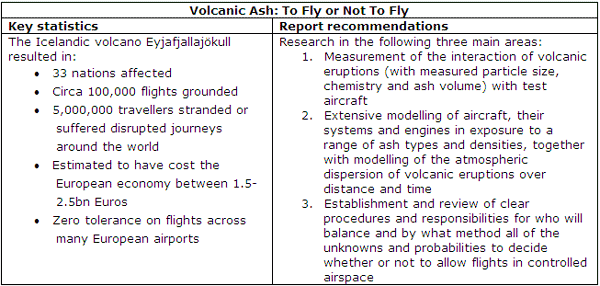Volcanic ash – could the chaos have been avoided?
- Like
- Digg
- Del
- Tumblr
- VKontakte
- Buffer
- Love This
- Odnoklassniki
- Meneame
- Blogger
- Amazon
- Yahoo Mail
- Gmail
- AOL
- Newsvine
- HackerNews
- Evernote
- MySpace
- Mail.ru
- Viadeo
- Line
- Comments
- Yummly
- SMS
- Viber
- Telegram
- Subscribe
- Skype
- Facebook Messenger
- Kakao
- LiveJournal
- Yammer
- Edgar
- Fintel
- Mix
- Instapaper
- Copy Link
Posted: 14 October 2010 | Institution of Mechanical Engineers (IMechE) | No comments yet
A new report by the IMechE has highlighted the need to test-fly aeroplanes through ash clouds caused by volcanic eruptions as the way to avoid chaos that was caused in future…
A new report by the Institution of Mechanical Engineers (IMechE) has highlighted the need to test-fly aeroplanes through ash clouds caused by volcanic eruptions as the way to avoid the chaos that was caused by the Icelandic eruption in the future.
Volcanic Ash: To Fly or Not to Fly suggests that the disruptions could have been less severe if data had been collected and shared more quickly.
A group of experts from the Institution compiled the report around Iceland’s Eyjafjallajökull volcano incident in April. The zero tolerance approach taken by European airports had to be maintained in the absence of any new data or research. As the ban on flying continued, this was later revised, but the restrictions still caused mass disruption, with more than 5,000,000 travellers being stranded around the world. The disruption is estimated to have cost the European economy between 1.5-2.5bn Euros.
The IMechE is suggesting regulatory authorities take measurements of ash density and particle size from aircrafts in ash clouds as and when opportunities arise in the future to improve understanding of the effects of volcanic ash on them. Data collection technology on test flights and close examination of its effect on aircraft engines will allow airlines and organisations such as the Civil Aviation Authority and the Met Office better control of future situations.
Professor Roderick Smith, who co-authored the report, said: “The clear recommendation from this report is that every opportunity should be taken for the regulatory authorities to collect field data. How this research should be funded is debatable at present due to the delicate financial state of the airline industry, however, the cost to travellers and flight disruption is also of huge importance.”















